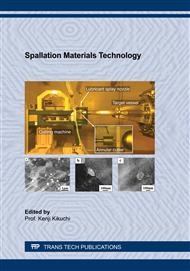p.27
p.41
p.53
p.71
p.79
p.87
p.95
p.103
p.111
Effect of Oxygen Concentration in Static Pb-Bi Eutectic on Corrosion Mode of Aluminum-Alloyed Austenitic Steels at 550 °C for 1000 h
Abstract:
Corrosion behavior of Fe-18Ni-12Cr-2.30Al and Fe-18Ni-12Cr-2.90Al-Nb-C austenitic steels was investigated in static Pb-Bi eutectic at 550 °C for 1000 h depending on the concentration of dissolved oxygen in the liquid metal. In the concentration range from 1012 to 108 mass % O, both steels underwent corrosion via dissolution resulted in the formation of spongy ferrite layer depleted in Ni and Cr and penetrated by Pb and Bi. In Pb-Bi with 106 mass % O, Fe-18Ni-12Cr-2.90Al-Nb-C steel oxidizes with formation of very thin (≤ 1 μm) Cr/Al oxide film while Fe-18Ni-12Cr-2.30Al steel shows mixed corrosion behavior represented by more intensive oxidation and dissolution. The features of corrosion response are discussed depending on the composition of steels and concentration of dissolved oxygen in the Pb-Bi eutectic.
Info:
Periodical:
Pages:
79-85
Citation:
Online since:
March 2021
Price:
Сopyright:
© 2021 Trans Tech Publications Ltd. All Rights Reserved
Share:
Citation:


